Conversational AI applies to the technology that lets chatbots and virtual assistants communicate with humans in a natural language.
Conversational AI apps use NLP (natural language processing) technology to interpret user input and understand the meaning of the written or spoken message. Moreover, it uses machine learning to collect data from interactions and improve the accuracy of responses over time.
Okay—
But how can you make the most out of this technology?
That’s what we’ll focus on today.
In this article:
- Components of conversational AI
- How does conversational AI work?
- Why does your business need it
- Examples with use cases
- How to create your own conversational AI
- Top conversational AI platforms
- Frequently asked questions
Get the best conversational AI chatbots for your business
If you’re interested in AI, check out these articles and in-depth studies on the topic:
- 10+ Essential AI Statistics You Need to Know
- AI Recruitment Statistics: What Is the Future of Hiring?
- Will AI Take Your Job? Fear of AI and AI Trends
First things first—
Let’s dive into what’s involved in conversational intelligence software.
Conversational AI components
Conversational AI systems combine NLP with machine learning technology to analyze and interpret user input, such as text or speech. Then, they extract meaningful information and respond appropriately.
This technology also learns through interactions to provide more relevant replies in the future.
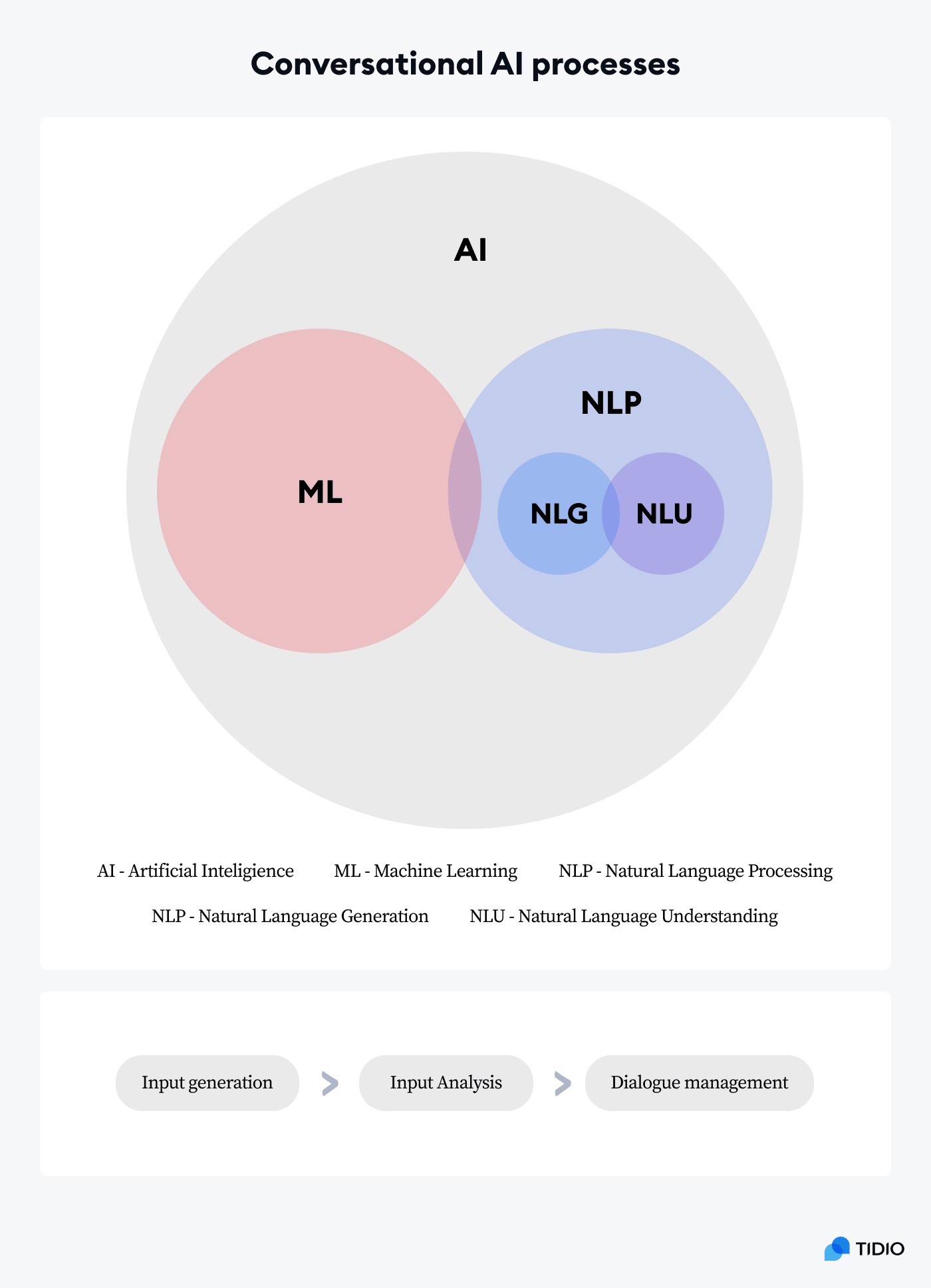
To understand the processes that go on in AI conversational platform, let’s get some of the definitions straight:
- NLP—Natural language processing translates unstructured data into information that machines can understand and produce an appropriate response to. It consists of two crucial parts—natural language understanding and natural language generation.
- NLU—Natural language understanding brings out the context, intents, and structure of the information to determine the meaning of the input.
- NLG—Natural language generation modifies the structured data in order to produce language readable to humans based on the provided input.
- ML—Machine learning is a set of algorithms and data sets that improve the responses of the conversational AI assistant and the recognition of patterns with experiences to make better predictions in the future.
- Input generation—Text or voice input that a user provides to the AI conversational software.
- Input analysis—The process of analyzing the input with the use of NLU and automated speech recognition (ASR) to identify the meaning of the language data and find the intent of the query.
- Dialogue management—A process where NLG, and machine learning work together to formulate an accurate response to the user’s input.
These components and processes enable conversational intelligence software to untangle data into a readable format and analyze it to generate a response.
Let’s see how do these processes actually work together.
How conversational AI works
In simple terms—artificial intelligence takes in human language and turns it into data that machines can understand. Then the language model creates a relevant response to the user. But there’s actually more going on behind the scenes than you might think.
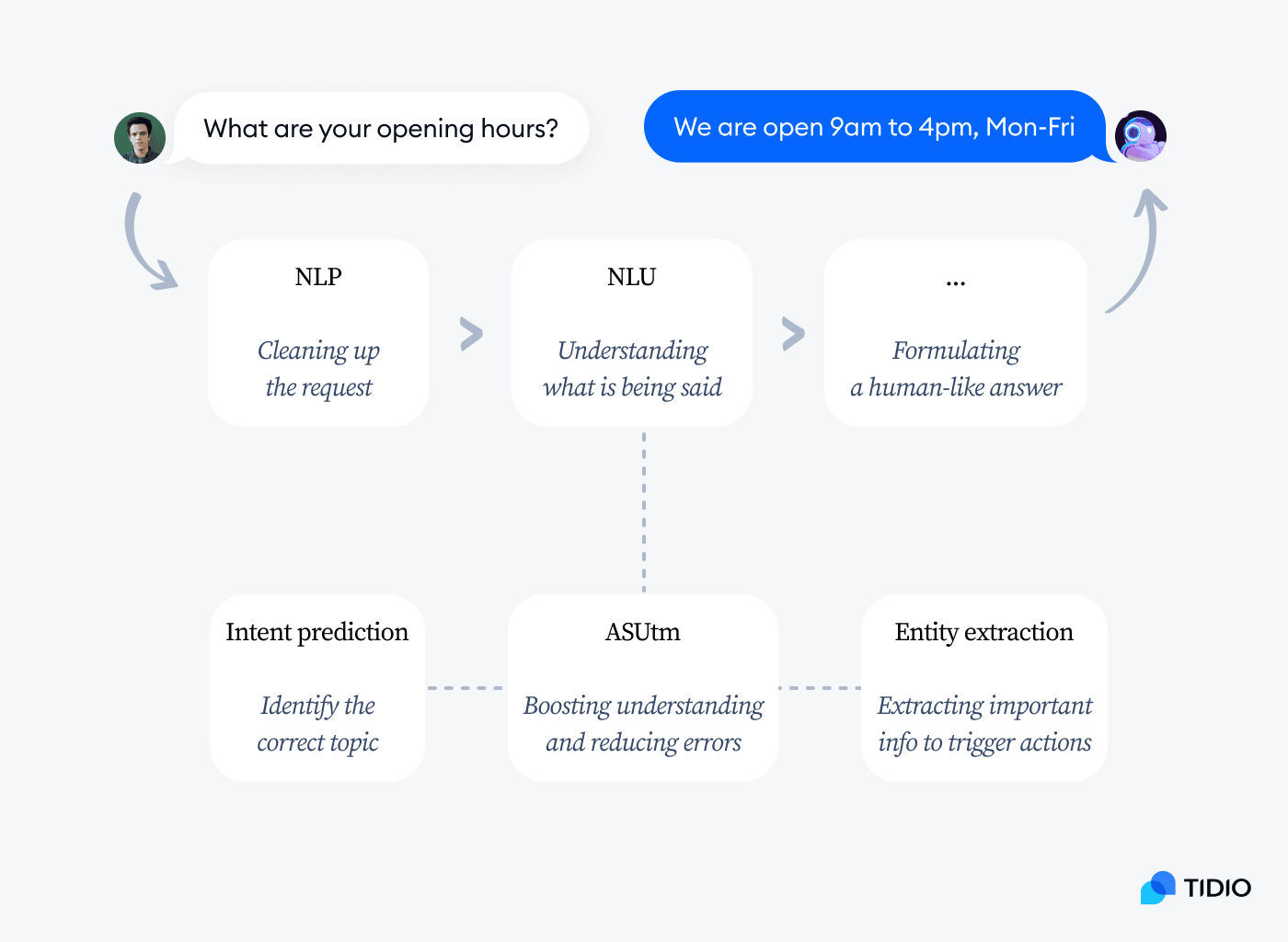
Conversational artificial intelligence platforms usually work in three main stages after a user inputs the query into the chat:
- Natural language processing is used to break down the query, identify the sentiment, and restructure the sentence to make it easier to understand.
- Then, deep learning, and natural language understanding pick out the intent of the request and take any relevant information from the query. In this stage of the process, the software understands the user’s input.
- In the third step, the conversational automation formulates a response to the user. It uses the conversation flow to respond appropriately to the question or perform the right action. With each inquiry, the system learns and becomes smarter. So, with time, it can answer more and more complex questions.
Conversational AI tools can help to free up your time and make your life that little bit easier.
They’re able to replicate human-like interactions, increase customer satisfaction, and improve user experiences.
But, is conversational AI synonymous with chatbots?
Not exactly.
You can think of chatbots as a type of conversational AI. They typically appear in a chat widget interface and interact with users via text messages on a website, social media, and other communication channels.
On the other hand, conversational artificial intelligence covers a broader area of AI technologies that can simulate conversations with users.
What about conversational AI vs. generative AI?
In simple terms—conversational AI models focus on offering an interactive dialogue, whereas generative AI produces entirely new content from the input provided.
Read more: Check out this in-depth comparison of chatbots vs conversational AI and discover all the differences. Also, learn more about rule-based chatbots and how they work.
Now—
What advantages conversational assistants can bring you, business-wise?
Benefits of using conversational AI in customer service
Gartner research forecasted that conversational AI will reduce contact center labor costs by $80 billion in 2026. There’s no hiding that conversational AI is rapidly transitioning into an essential asset for businesses across various scales.
Here’s why:
Increased sales
Implementing conversational AI can lead to increased sales and improved customer satisfaction. In fact, The global conversational AI market size is projected to exceed $73 billion by 2033.
Tailored support
With conversational AI, businesses can provide 24/7 support tailored to individual customer needs, eliminating long wait times and frustrating phone trees. And according to Google, shoppers are 40% more likely to spend more with a company that provides a highly personalized shopping experience.
Valuable customer insights
After each chat, the conversational AI integration can ask your website visitors for their feedback, collect their data, and save the chat transcript. On top of that, research shows that about 77% of consumers view brands that ask for and accept feedback more favorably than those that don’t.
And businesses know those benefits–
Gartner predicted that by 2023, 25% of customer service and support operations will integrate virtual customer assistant (VCA) or chatbot technology.
Improve your customer support with conversational AI
Now—
What can conversational AI platforms be used for?
Let’s see which businesses are reaping these benefits.
Conversational AI use cases and examples
What do you think of when you hear of AI applications?
Customer service chatbots and voice assistants might come to mind. You’ve seen them and you’ve probably used them.
Let’s have a look at the most popular examples of conversational AI use cases.
Conversational AI for customer service
Conversational assistants help human agents with online customer service and become virtual shopping assistants for shoppers. They answer FAQs, provide personalized recommendations, and upsell products across multiple channels including your website and Facebook Messenger.
Sephora’s virtual assistant is an example of conversational AI in retail used well:
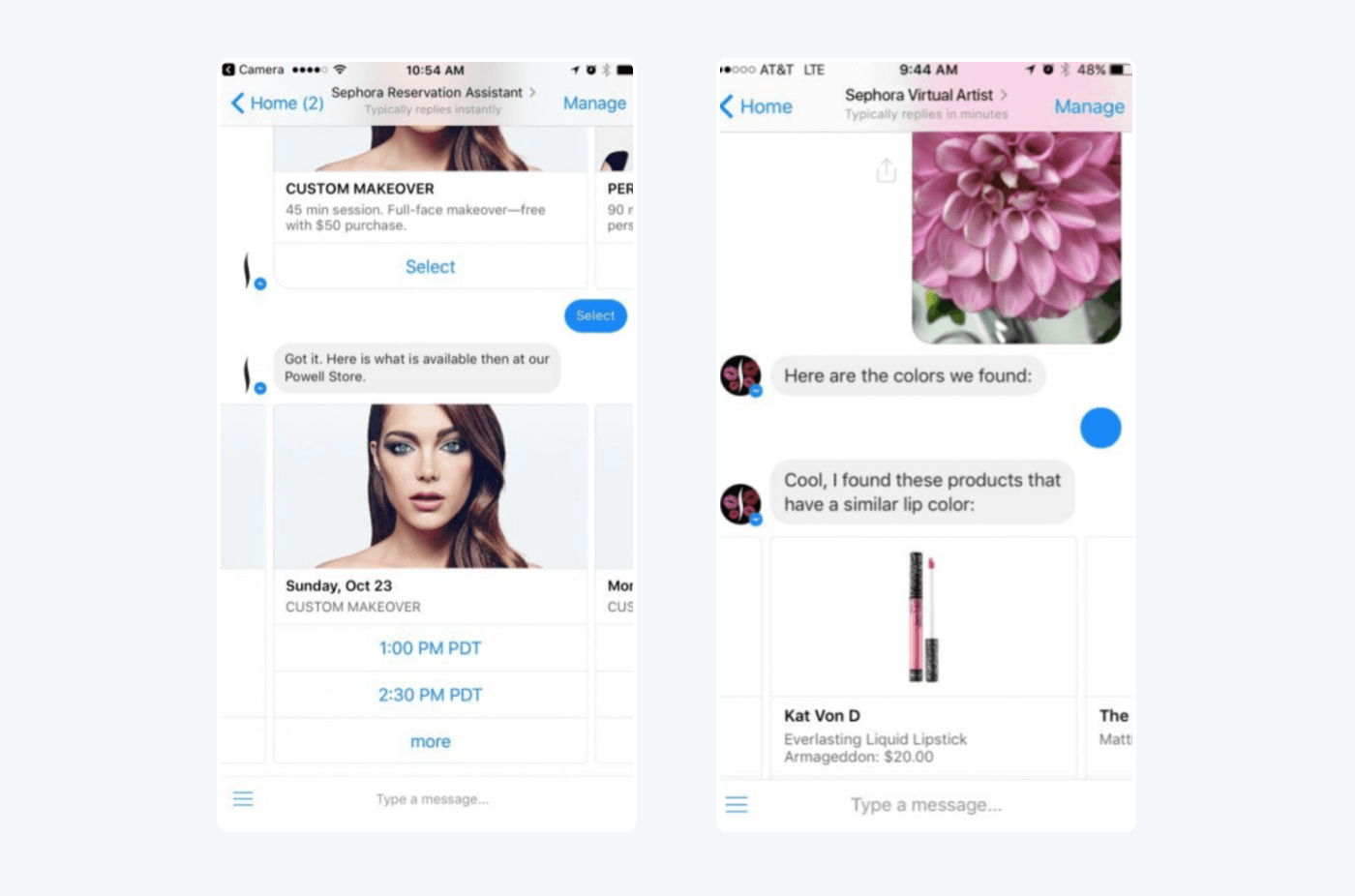
Read more: Learn all about how you can use conversational AI for sales. Check out the best sales chatbots that will boost your revenue.
Conversational AI in hospitality
Just as in retail, conversational AI hospitality can help restaurants and hotels ease their order processes and increase the efficiency of service.
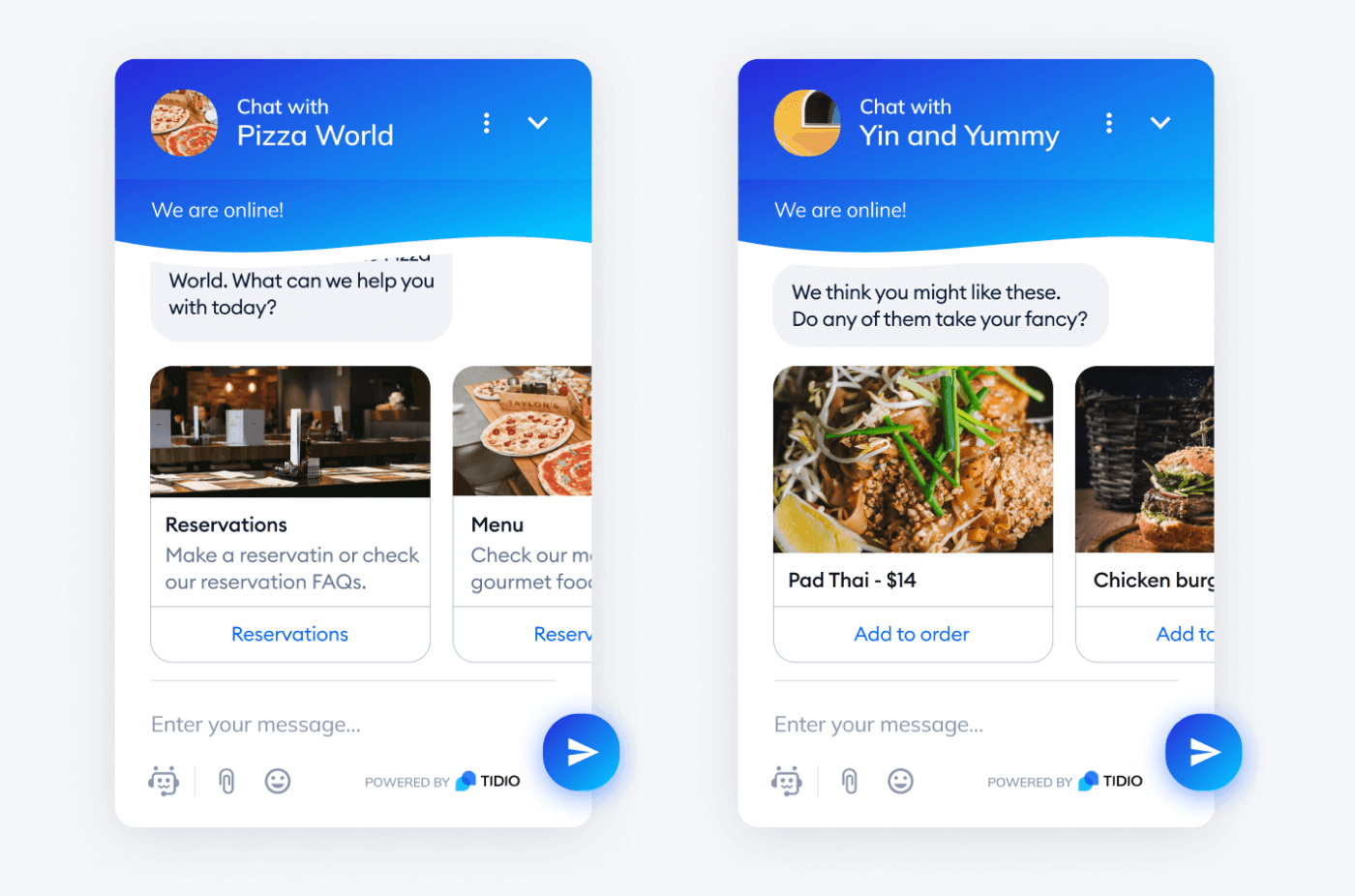
Let’s say that your restaurant is offering a takeaway service. Instead of taking orders on the phone, you can add a chatbot to your website and social media that will do it automatically. It can show your menu to the client, take their order, ask for the address, and even give them an estimated time of delivery.
In fact, our study into the future of chatbots shows that 59% of customers prefer to use chatbots for ordering food.
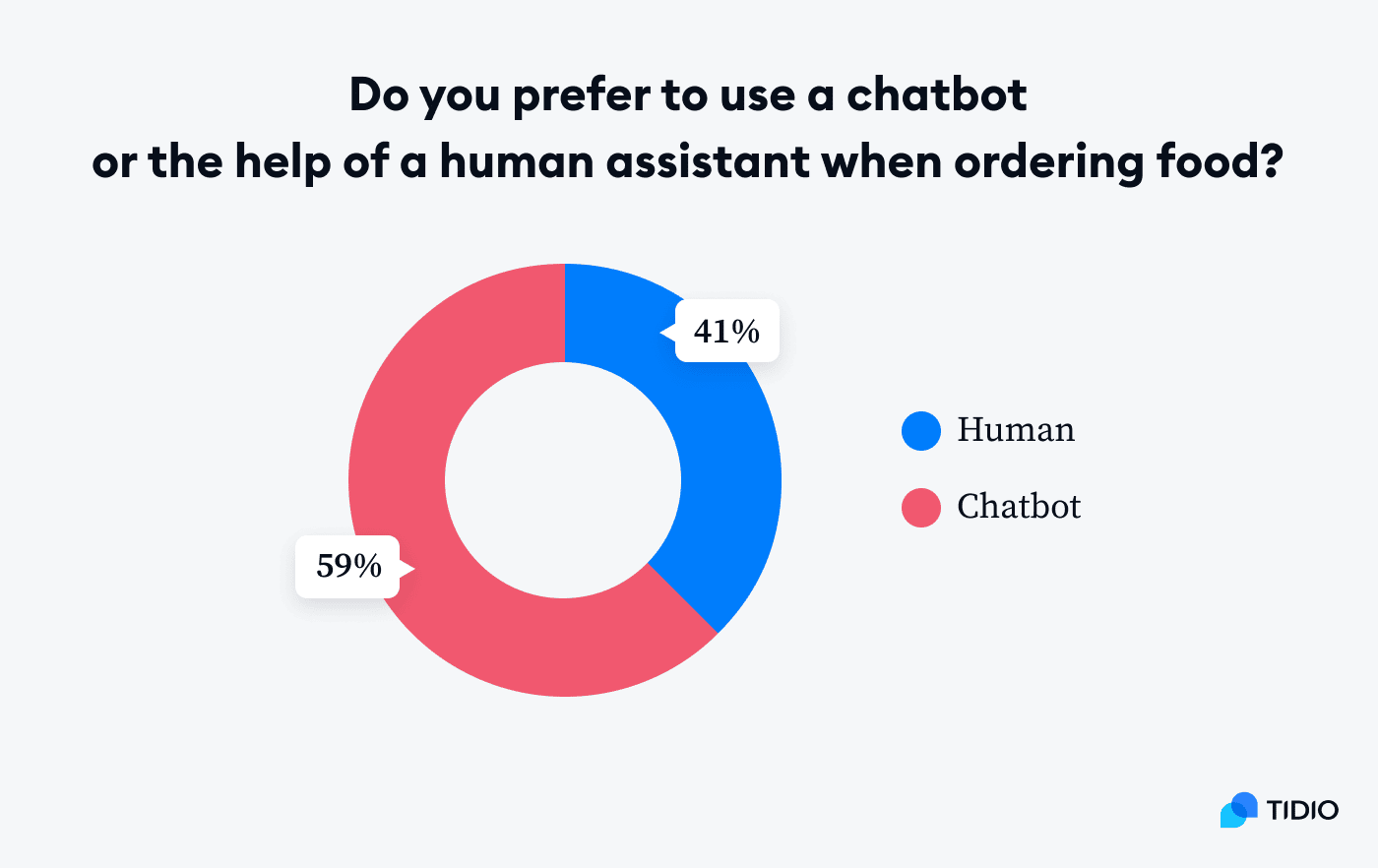
Conversational bot for human resources
You might be wondering how conversational AI can help in the HR department. It’s all about human contact and interactions, isn’t it?
Well—yes, but AI can help candidates to get all the information they need straight away and update them on the hiring process. Also, it can automate your internal feedback collection, so you know exactly what’s going on in your company. Conversational AI platforms can also help to optimize employee training and onboarding.
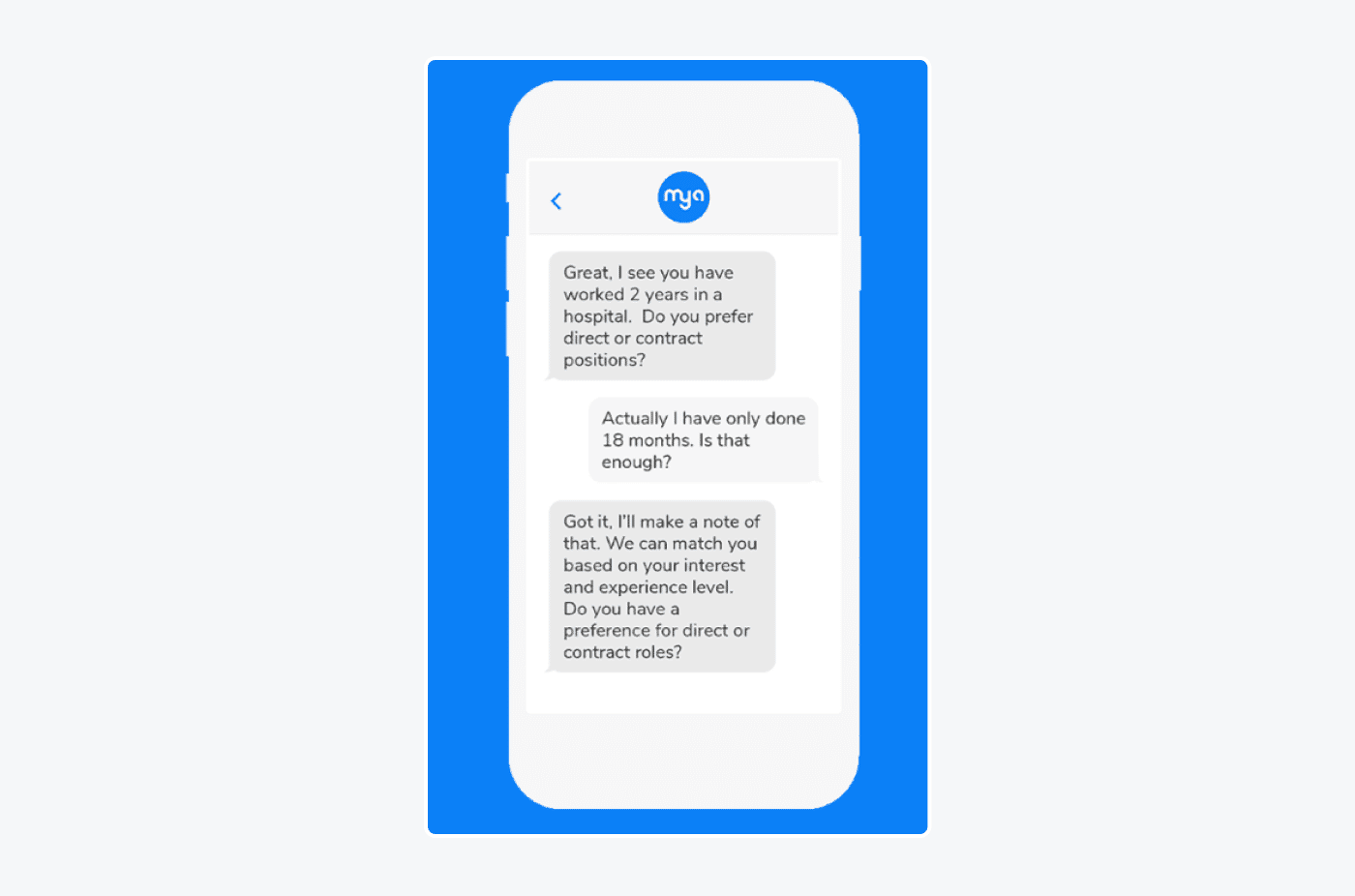
Conversational AI in healthcare
Conversational AI healthcare applications can be used for checking symptoms, scheduling appointments, and reminding you to take medication. It makes the healthcare system more accessible for all patients. That’s because anyone can get accurate help right when they need it, no matter where they are or how busy their doctor is.
It can also improve the administrative processes and the efficiency of operations. It collects relevant data from the patients throughout their interactions and saves it to the system automatically. This way, the doctor gets a fuller picture of the patient’s health conditions.
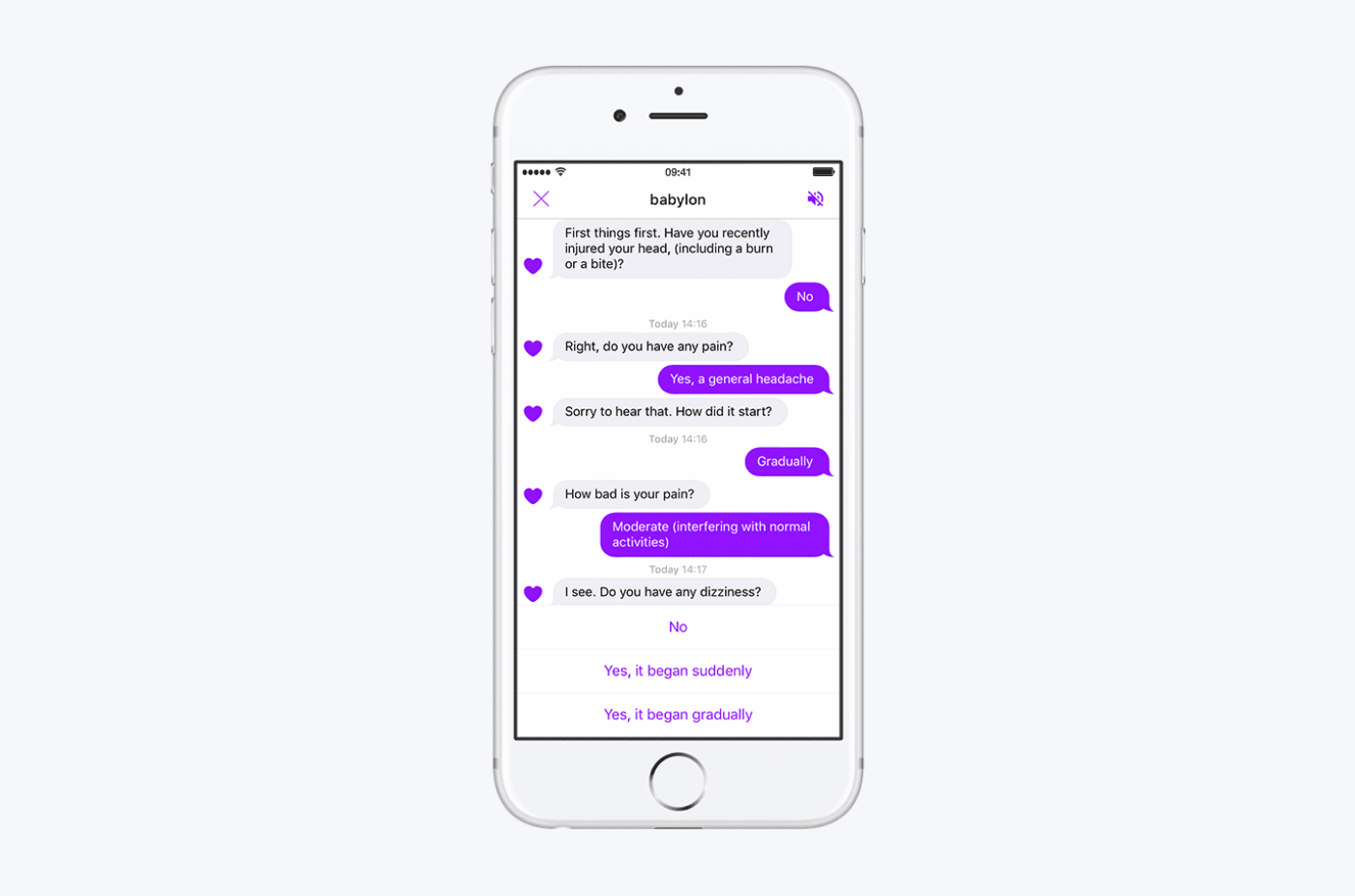
IoT devices
Chances are you have a mobile phone, a smartwatch, or Alexa in your home. These devices use sensors that connect with each other to process and exchange information.
This conversational AI technology also uses speech recognition that allows your smart home assistant to perform tasks, such as turning off the lights and setting your morning alarm.

Some of the most popular IoT applications used at home include Siri (Apple), Alexa (Amazon), and Google Home.
Research shows that the Internet of Things has been getting more and more attention lately. In fact, worldwide spending on the IoT increased by $63 billion between 2019 and 2020.
Read more: Learn more about the Internet of Things including what it is, how it works, and some examples.
Moving on—
Let’s have a look at the top conversational AI companies, shall we?
Conversational AI platforms
Insert the phrase “conversational AI” into G2, and you’ll get over 200 results. All of these companies claim to have innovative software that will help your business and your personal needs. But going through them all to separate wheat from the chaff would take days.
Don’t worry, we’ve done it for you and chosen only the best of the best to include in our list.
So, three of the best conversational AI are:
1. Lyro by Tidio
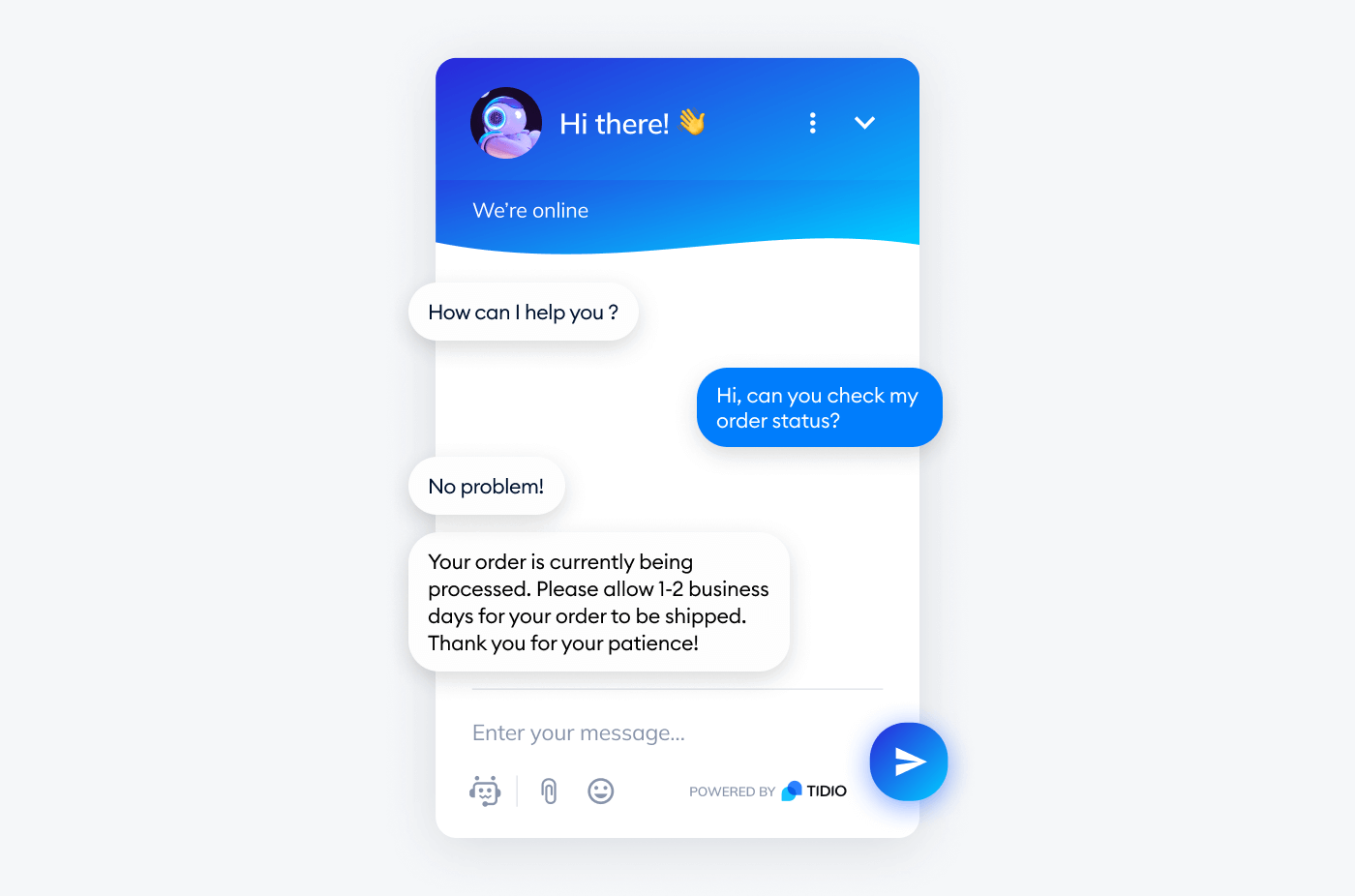
Rating: 4.7/5 ⭐️ (1,440+ reviews)
Before you point fingers at us—yes, this is our software, but we won’t toot our own horn here.
So, let’s keep it short and sweet.
Tidio offers a conversational AI bot that helps you improve the customer experience with your brand. It uses deep learning and NLP chatbots to engage your shoppers better and generate more sales. This platform also provides chatbot templates and a visual builder interface that make it easy to make your first chatbots.
Check out our reviews and try Tidio conversation AI free of charge to decide for yourself if we deserve this spot on the list.
Main features:
- Automatic segmentation of questions
- Feedback collection
- Self-learning mechanism
- Free version available
- Starter ($29/mo)
- Flows ($29/mo)
- Lyro AI ($39/mo)
- Growth ($59/mo)
- Tidio+ (starts at $749/mo)
Read more: Learn how to add Tidio AI chatbots to your website and how to use them.
2. Watson assistant IBM
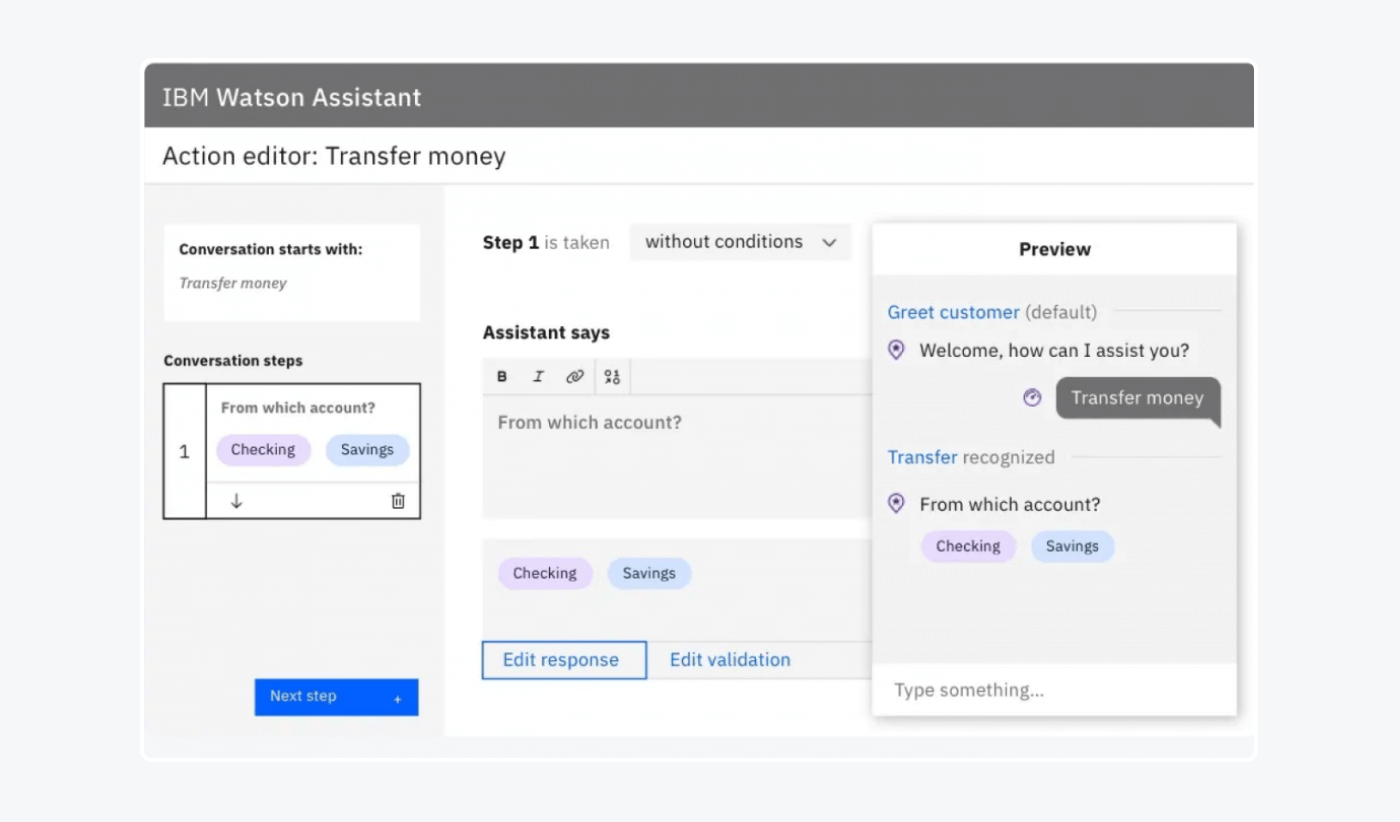
Rating: 4.4/5 ⭐️ (285+ reviews)
This open-source conversational AI company enables developers to build chatbots for simple as well as complex interactions. It provides a cloud-based NLP service that combines structured data, like your customer databases, with unstructured data, like messages.
This platform also takes security and privacy matters seriously with measures, such as visual recognition security and a private cloud for your users’ data.
Main features:
- Customer sentiment analysis
- Custom categories classification
- Predictive analytics
- Free conversational AI plan available
- Plus (from $140/mo)
- Enterprise → custom pricing
3. Zendesk
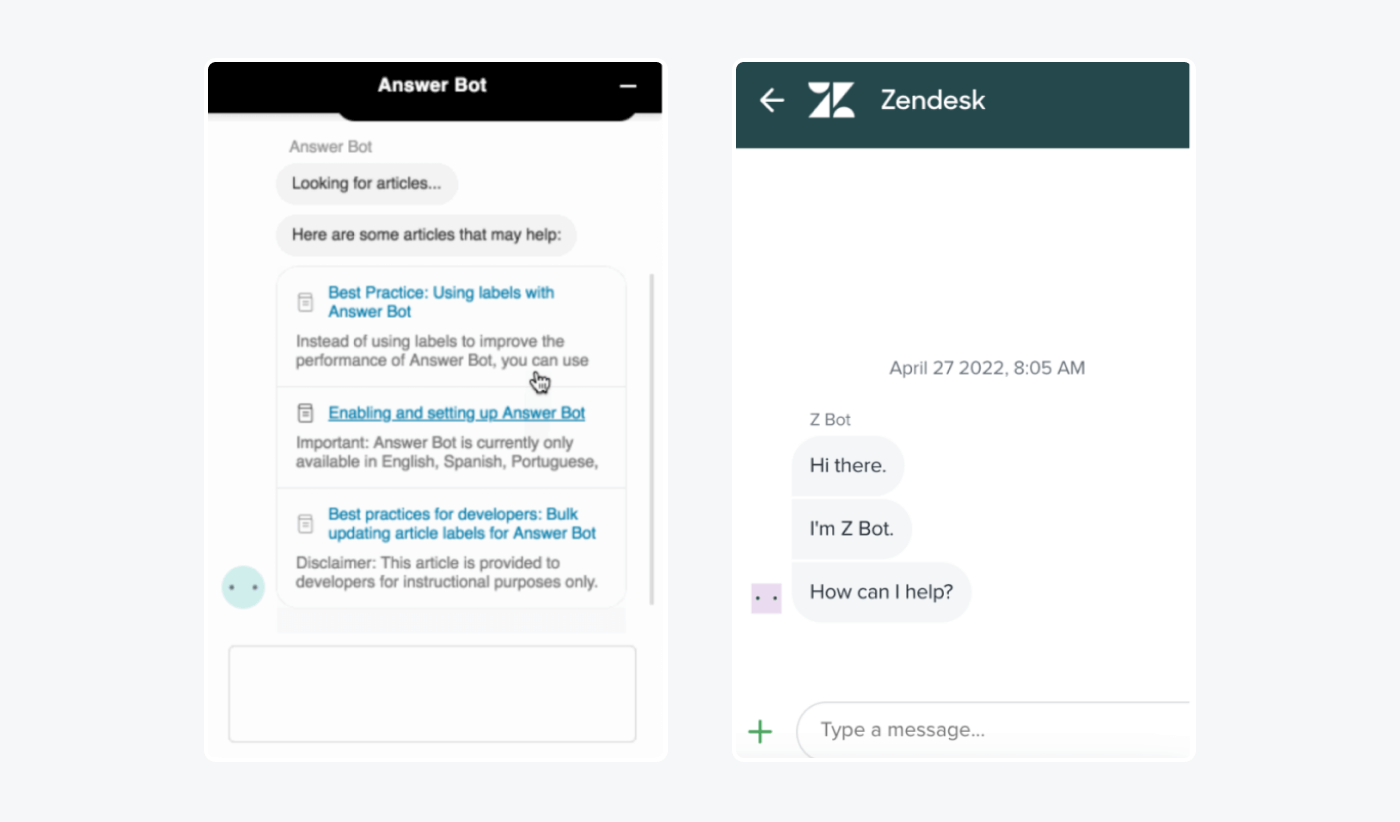
Rating: 4.3/5 ⭐️ (5,825+ reviews)
This is one of the best conversational AI that enables better organization of customer support with pre-chat surveys, ticket routing, and team collaboration. It’s one of the providers that offers a mobile app for real-time customer support, as well as monitoring and managing your chats on the go.
Zendesk is also a great platform for scaling your business with automated self-service available straight on your site, social media, and other channels.
Main features:
- Custom forms
- Ticketing system
- Visual flow builder
- Suite Team ($69/mo/operator)
- Suite Growth ($115/mo/operator)
- Suite Professional ($149/mo/operator)
- Suite Enterprise → contact sales team
Now you’re probably wondering how can you build a conversational AI for your business. Let’s dive into that.
How to create conversational AI for customer service?
It all starts with thinking, planning, and analyzing—what do you need the system to do, what questions do you need it to answer, and how do you want it to interact with users?
To do that, you need to first analyze the current customer interactions, their intents, and commonly asked questions. This will help your conversational AI applications to efficiently route the visitor to the relevant information.
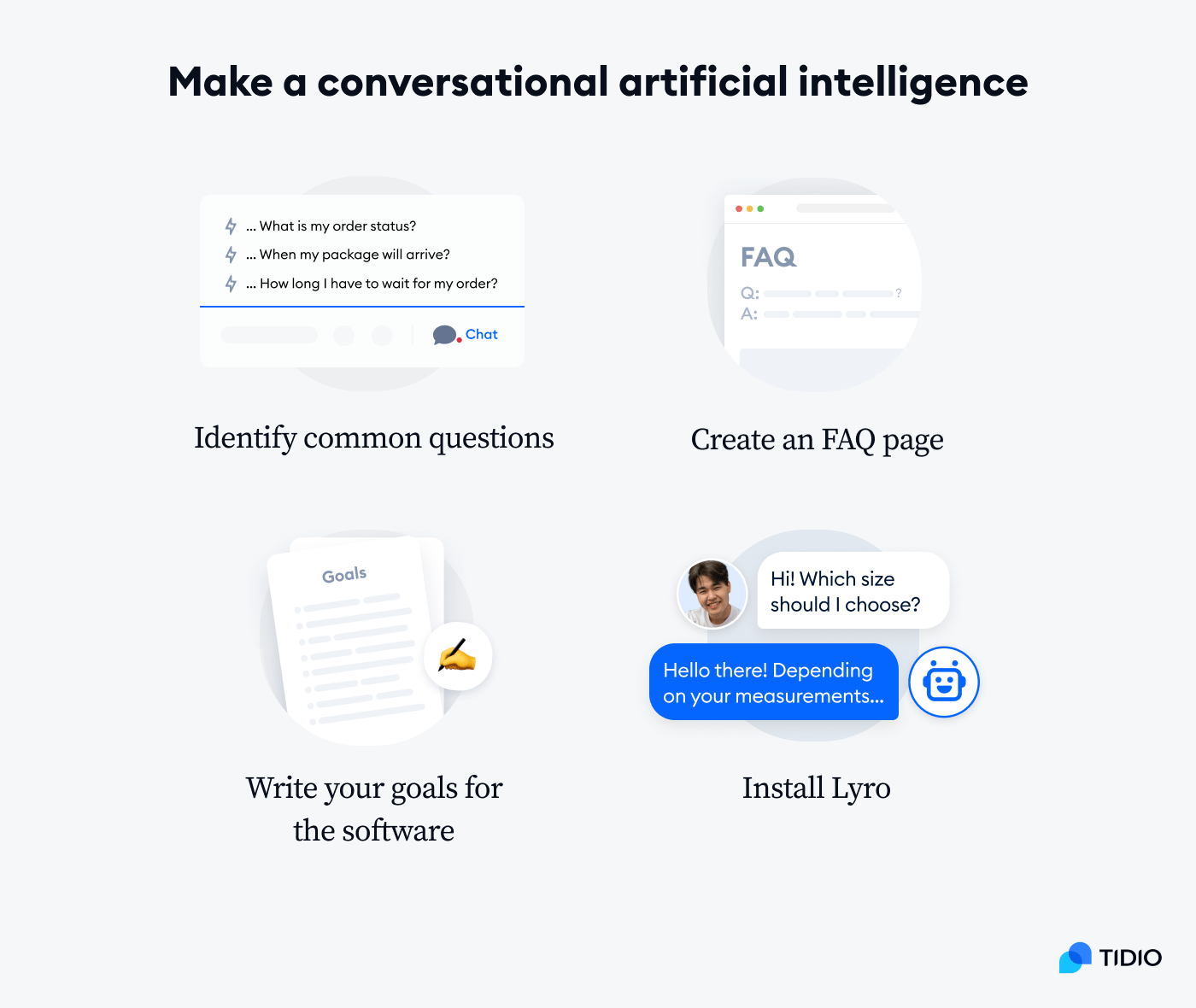
So, you can make conversational AI in 4 steps:
1. Identify your users’ frequently asked questions (FAQs)
Start by going through the logs of your conversations and find the most common questions buyers ask. This is an essential foundation for your conversational AI processes. These customer inquiries determine the main user intents and needs of your shoppers, which can then be served on autopilot.
As an example, these FAQs could include What are your opening hours?, What are your pricing plans?, What’s your return policy? questions, and many more.
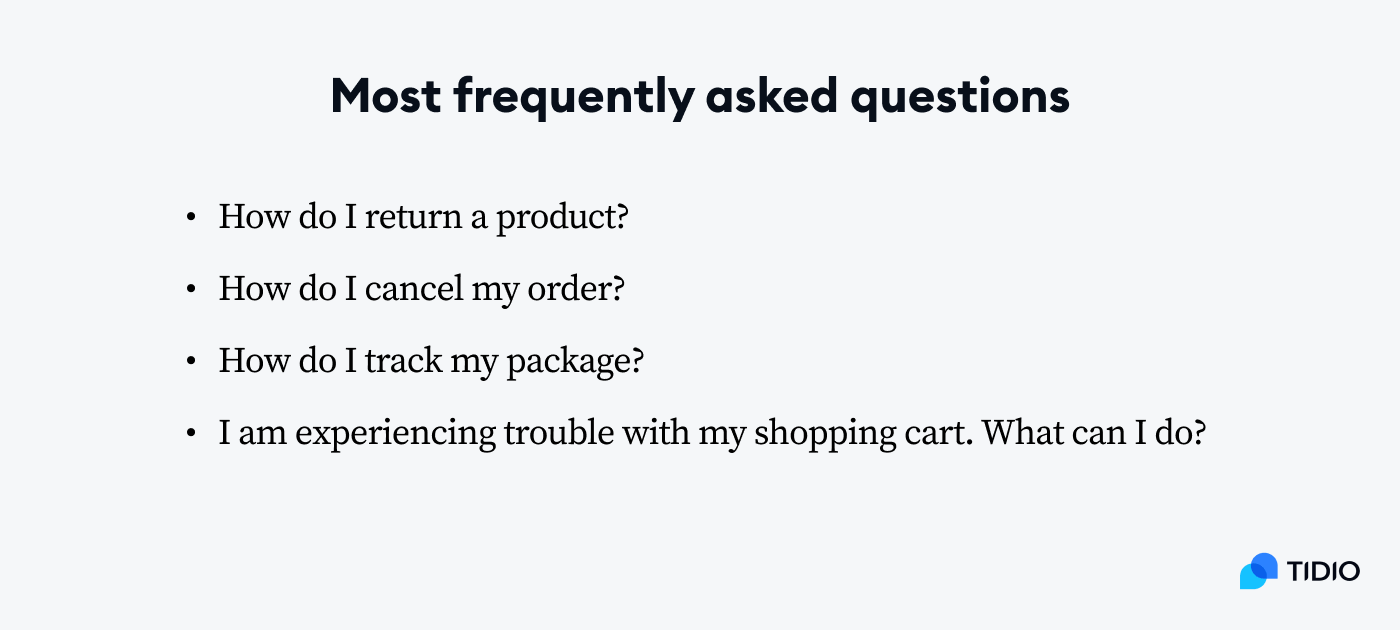
2. Design goals for your tool
Based on your FAQs, outline the main goals and intents of your users.
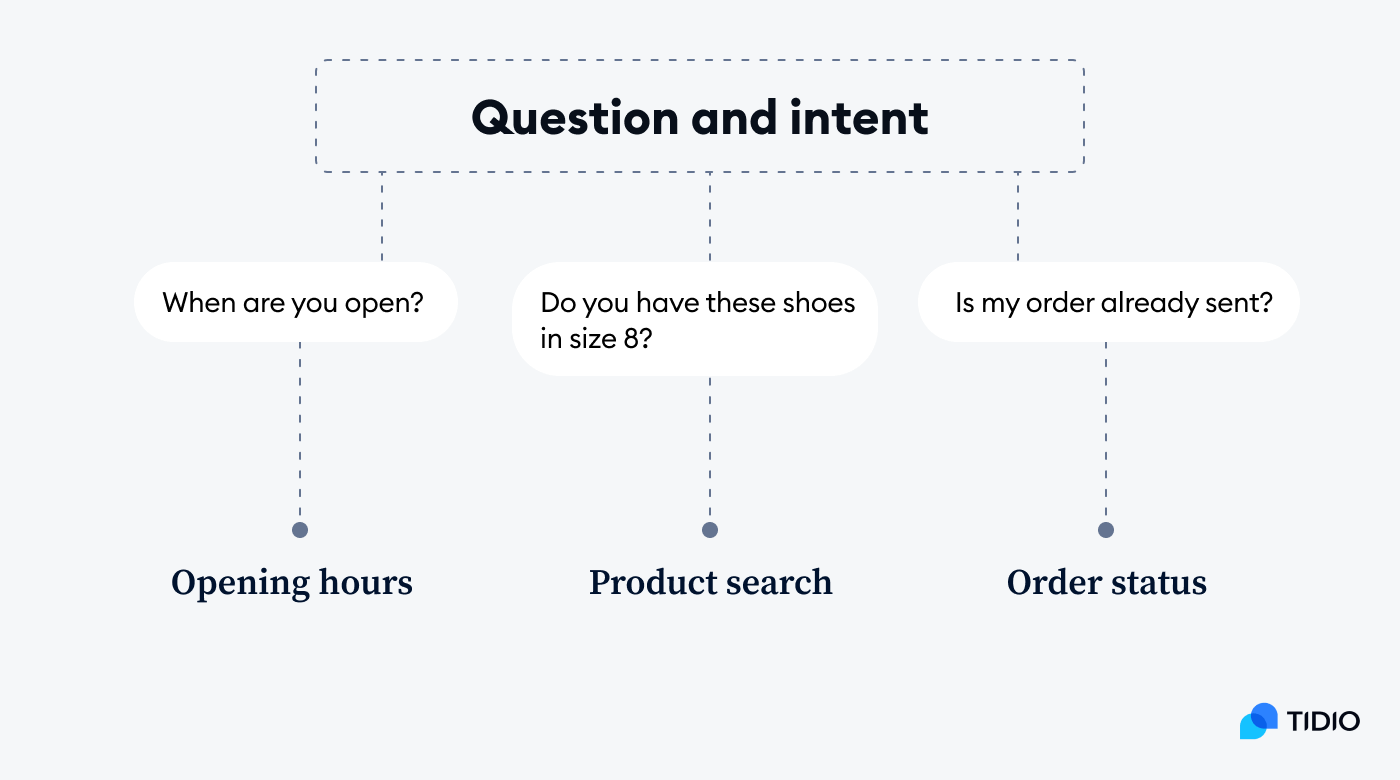
You can create a number of conversational AI chatbots and teach them to serve each of the intents. But remember to include a variety of phrases that customers could use when asking for a specific type of information.
Your support team can help you with that, as they know the phrases used by clients best.
3. Create an FAQ page or sheet
Take the list of questions that your conversational AI solution can fulfill and write down the answers for each FAQ. The software needs to have the right responses in order to provide relevant information to your visitors. Ensure your answers are concise and complete in order to give users the best experience.
Here’s an example of a good FAQ page from NYX:
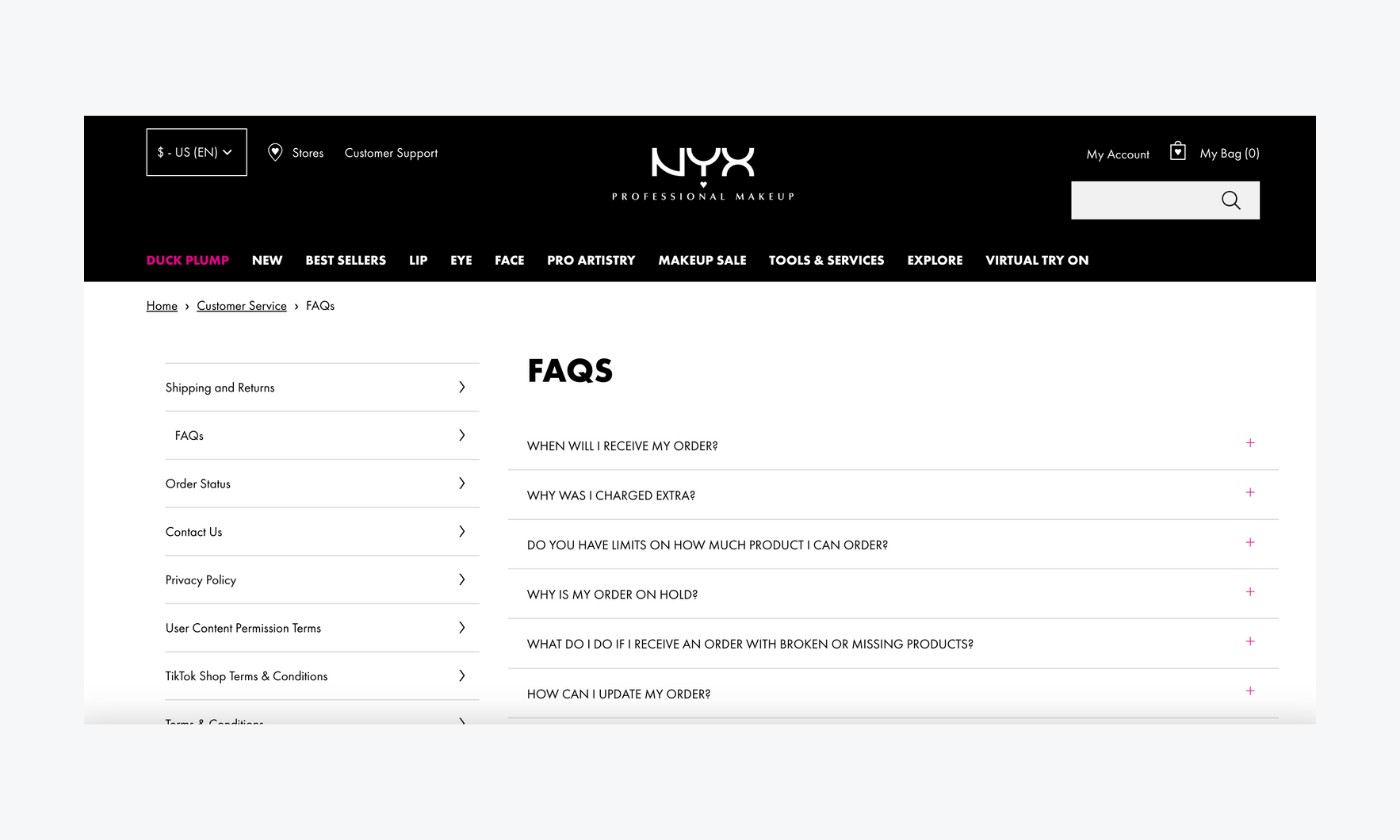
Read more: Learn how to create a good FAQ for Lyro.
4. Implement Lyro to your site
Log in to Tidio and go to the Lyro tab on your dashboard. Press Start using Lyro and click Accept once you’ve read the restrictions.
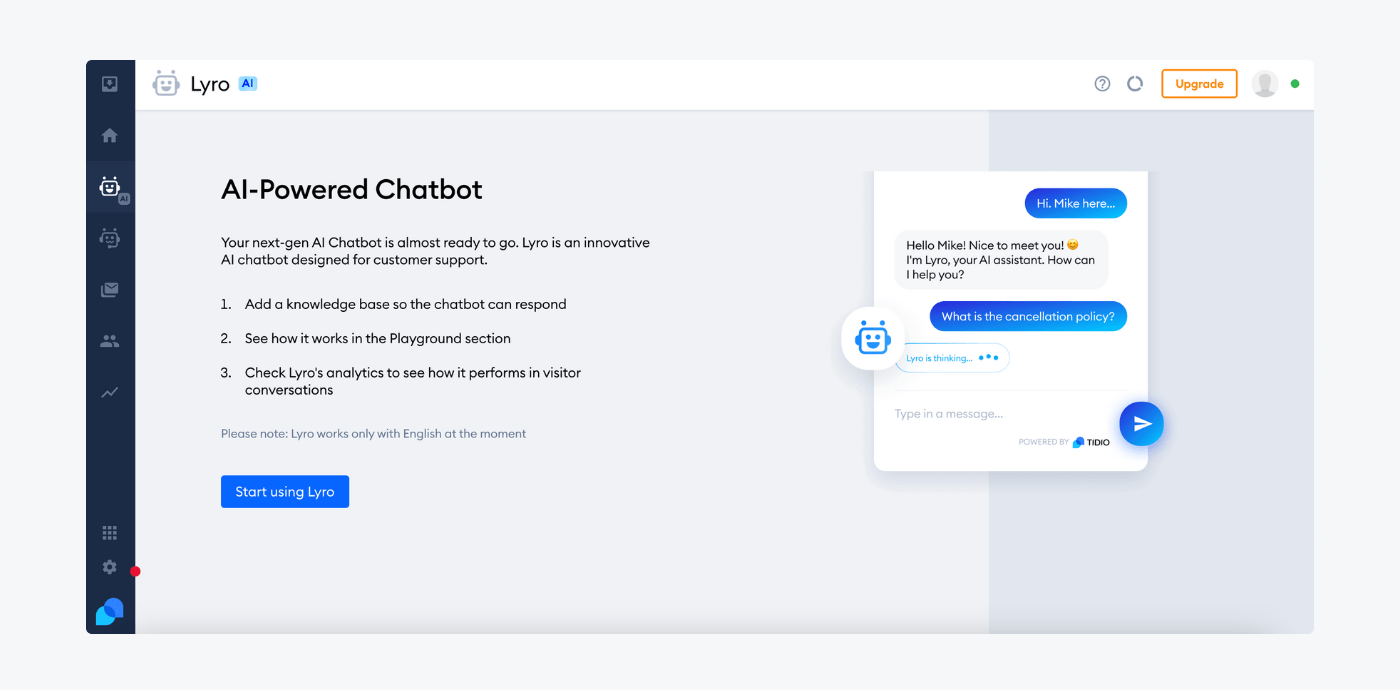
Now you can choose to import your FAQs from the website’s URL or from an external FAQ page. Insert the link in the box and click Import.
This conversational AI software solution will automatically upload all the question-answer pairs to its database so you can start using the chatbots straight away.
Read more: Learn how the Tidio support team used Lyro to achieve over 58% automation. Also, follow the step-by-step guide and best practices for Lyro AI training.
Conversational AI: summary
That’s all for today. Give yourself a minute to process it all, as we’ve learned quite a bit today.
Let’s do a quick recap first, though.
Conversational AI is a software which can communicate with people in a natural language using NLP and machine learning. It helps businesses save time, enables multilingual 24/7 support, and offers omnichannel experiences. This technology also provides personalized recommendations to clients, and collects shoppers’ data.
To create a conversational AI for customer service, you should first identify your users’ commonly asked questions and design goals for your tool. Then ensure to use keywords that match the intent when training your artificial intelligence. Finally, write the responses to the questions that your software will use to communicate with users.
The best conversation AI platforms on the market are Tidio, IBM Watson Assistant, and Zendesk.
Now—make the most out of this technology. People are developing it every day, so artificial intelligence can do more and more. Don’t get left behind! Jump on the train and get a competitive advantage over your competitors.
Improve your customer support with conversational AI
FAQs
A conversational AI solution refers to any software that can talk to a user. It allows you to automate customer service workflows or sales tasks, reducing the need for human employees. It can be integrated with a bot or a physical device to provide a more natural way for customers to interact with companies.
Some common examples of conversational AI include chatbots, virtual assistants, and customer service robots. The goal of most conversational AI systems is to mimic human conversation as closely as possible, often through the use of machine learning (ML) algorithms. For instance, virtual assistants, such as Amazon’s Alexa or Apple’s Siri, are designed to answer users’ questions in a conversational manner.
The key differentiator of conversational AI is the use of natural language processing (NLP) and machine learning to mimic human interaction. This process works on the basis of keyword recognition, automatic speech recognition, and output generation.
The cost of building a chatbot and maintaining a custom conversational AI solution will depend on the size and complexity of the project. However, it’s safe to say that the costs can range from very little to hundreds of thousands of dollars.
Conversational AI uses natural language processing and machine learning to communicate with users and improve itself over time. It gathers information from interactions and uses them to provide more relevant responses in the future.
Some of the best conversational AI include Apple’s Siri, Amazon’s Alexa, Google Assistant, Tidio chatbots, and Watson Assistant IBM.
Conversational AI includes a wide spectrum of tools and systems that allow computer software to communicate with users. AI-powered chatbots are one of the software that uses conversational AI to interact with people.
Yes, Siri is an example of a conversational AI tool. It uses automated voice recognition to interact with users and artificial intelligence to learn from each conversation.
Yes, Amazon Alexa is an example of conversational AI. It uses a voice user interface (VUI) and AI to communicate with people and learn over time.
The main types of conversational AI are voice assistants, text-based assistants, and IoT devices.
Some of the main benefits of conversational AI for businesses include saving time, enabling 24/7 support, providing personalized recommendations, and gathering customer data.

